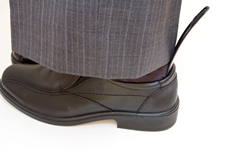AARP Hearing Center

“Which shoes,” the caregiver asks, as she comes to the final step in getting me up and dressed.
There’s suspense, wonderment, and surprise in the personal togetherness of putting my best foot forward. It’s not a “ho hum” daily activity. I’ve engaged in this morning ritual before with many diverse caregivers. It’s been almost a decade that I’ve been known as one-zero-eight, my room number, the distinguishing marker for a resident in an Assisted Living Facility (ALF.)
. The names of all residents are assembled on alphabetical lists. I am on B list and am assigned to whomever has my name on her list that particular month.
Before I became disabled in 2005 at age seventy-two – and compelled to live the ALF life - I had many decades of putting on and tying my own shoes. In summer, sandals obviated the process. I’ve also had over fifty years of putting on the tiny shoes of twelve children. Again, in summer time, flip-flops eliminated the difficult hand-eye coordination.
So, I had pre-conceived notions of what to expect. I was wrong!
Some caregivers believe in the “step-down-hard-enough-and-your-foot-will-eventually-fit-in ” method of putting on shoes. That’s OK if you can stand and swing your hips. (That’s how my always-in-a-hurry teenagers pushed their feet into pre-tied and ready-to-go shoes.) But I normally travel by wheelchair, and am dressed by a caregiver while sitting on the edge of the mattress. I don’t have the leg/foot power to press down hard enough to squeeze my foot into a shoe. (Nike, New Balance, or Adidas it’s all the same.)
So, I wind up using my butt to push down on the edge of the mattress, squeezing and wiggling my foot into the shoe.
Assaulting the shoe isn’t necessary if the shoe laces and upper collar are spread wide apart. It’s an easy glide in. I’m forced to attack the shoe only when the caregiver gives me a narrow slit in which to insert my foot. While I struggle to exert force with my foot, I plead, “loosen the laces and pull the lips wide apart.”
Once each foot has either been smoothly and gracefully slipped in, or painfully and wobbly shoved in, the strangely diverse way of lace tying begins.
I once thought you wrapped one lace around the other and pulled. Wrong! You create a bunny ear to go around the tree and through the hole. And if one ear doesn’t produce a tight enough fit to withstand an hour of walking and working out, then you create two bunny ears, criss cross them, and pull hard.
To some less metaphorically inclined caregivers, a bunny ear is a plain old knot, belonging to the slip family, which can be used by itself or helped by its sibling – that means double knotted for the non-poetic.
So, my shoes are on, duly laced, the act of dressing is done - until at night, when the ears are gradually separated and the shoes slipped off or they are left intact, and the shoes roughly and painfully pulled off.
Next morning, we’ll do it again.
Dick Weinman lives in an assisted living facility in Corvallis, Oregon.































































